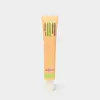What's inside
What's inside
 Key Ingredients
Key Ingredients

 Benefits
Benefits

 Concerns
Concerns

 Ingredients Side-by-side
Ingredients Side-by-side

Water
Skin ConditioningGlycerin
HumectantNiacinamide
SmoothingDistarch Phosphate
AbsorbentPropanediol
SolventOleic Acid
EmollientSclerotium Gum
Emulsion StabilisingSorbitan Olivate
EmulsifyingPunica Granatum Seed Oil
EmollientAscorbyl Palmitate
AntioxidantXylityl Sesquicaprylate
AntimicrobialCetearyl Olivate
Sodium Benzoate
MaskingDecyl Glucoside
CleansingLinoleic Acid
CleansingPotassium Sorbate
PreservativeBisabolol
MaskingLauryl Glucoside
CleansingTocopherol
AntioxidantHyaluronic Acid
HumectantAminomethyl Propanol
BufferingIron Oxides
Anhydroxylitol
HumectantAlgin
MaskingGlyceryl Undecylenate
EmollientTocopheryl Acetate
AntioxidantBentonite
AbsorbentGlyceryl Caprylate
EmollientCaffeine
Skin ConditioningMica
Cosmetic ColorantCI 77163
Cosmetic ColorantCaprylic/Capric Triglyceride
MaskingCalcium Citrate
BufferingCitric Acid
BufferingSodium Lauroyl Lactylate
EmulsifyingResveratrol
AntioxidantSodium Metabisulfite
AntioxidantWater, Glycerin, Niacinamide, Distarch Phosphate, Propanediol, Oleic Acid, Sclerotium Gum, Sorbitan Olivate, Punica Granatum Seed Oil, Ascorbyl Palmitate, Xylityl Sesquicaprylate, Cetearyl Olivate, Sodium Benzoate, Decyl Glucoside, Linoleic Acid, Potassium Sorbate, Bisabolol, Lauryl Glucoside, Tocopherol, Hyaluronic Acid, Aminomethyl Propanol, Iron Oxides, Anhydroxylitol, Algin, Glyceryl Undecylenate, Tocopheryl Acetate, Bentonite, Glyceryl Caprylate, Caffeine, Mica, CI 77163, Caprylic/Capric Triglyceride, Calcium Citrate, Citric Acid, Sodium Lauroyl Lactylate, Resveratrol, Sodium Metabisulfite
Water
Skin ConditioningGlycerin
HumectantEthylhexyl Cocoate
EmollientMethylpropanediol
SolventCetyl Alcohol
EmollientHydrogenated Coco-Glycerides
EmollientStearyl Alcohol
EmollientButylene Glycol
HumectantCaprylic/Capric Triglyceride
MaskingButyrospermum Parkii Butter
Skin ConditioningGlyceryl Stearate Citrate
EmollientMacadamia Ternifolia Seed Oil
EmollientUbiquinone
AntioxidantCreatine
Skin Conditioning1-Methylhydantoin-2-Imide
Skin ConditioningPanthenol
Skin ConditioningLanolin Alcohol
EmollientTridecyl Stearate
EmollientTridecyl Trimellitate
EmollientDipentaerythrityl Hexacaprylate/Hexacaprate
EmulsifyingSodium Carbomer
Emulsion StabilisingEthylhexylglycerin
Skin ConditioningPhenoxyethanol
PreservativeTrisodium EDTA
Limonene
PerfumingLinalool
PerfumingBenzyl Alcohol
PerfumingCitronellol
PerfumingGeraniol
PerfumingAlpha-Isomethyl Ionone
PerfumingBenzyl Salicylate
PerfumingHexyl Cinnamal
PerfumingParfum
MaskingWater, Glycerin, Ethylhexyl Cocoate, Methylpropanediol, Cetyl Alcohol, Hydrogenated Coco-Glycerides, Stearyl Alcohol, Butylene Glycol, Caprylic/Capric Triglyceride, Butyrospermum Parkii Butter, Glyceryl Stearate Citrate, Macadamia Ternifolia Seed Oil, Ubiquinone, Creatine, 1-Methylhydantoin-2-Imide, Panthenol, Lanolin Alcohol, Tridecyl Stearate, Tridecyl Trimellitate, Dipentaerythrityl Hexacaprylate/Hexacaprate, Sodium Carbomer, Ethylhexylglycerin, Phenoxyethanol, Trisodium EDTA, Limonene, Linalool, Benzyl Alcohol, Citronellol, Geraniol, Alpha-Isomethyl Ionone, Benzyl Salicylate, Hexyl Cinnamal, Parfum
Ingredients Explained
These ingredients are found in both products.
Ingredients higher up in an ingredient list are typically present in a larger amount.
This ingredient is an emollient, solvent, and texture enhancer. It is considered a skin-softener by helping the skin prevent moisture loss.
It helps thicken a product's formula and makes it easier to spread by dissolving clumping compounds.
Caprylic Triglyceride is made by combining glycerin with coconut oil, forming a clear liquid.
While there is an assumption Caprylic Triglyceride can clog pores due to it being derived from coconut oil, there is no research supporting this.
Learn more about Caprylic/Capric TriglycerideGlycerin is already naturally found in your skin. It helps moisturize and protect your skin.
A study from 2016 found glycerin to be more effective as a humectant than AHAs and hyaluronic acid.
As a humectant, it helps the skin stay hydrated by pulling moisture to your skin. The low molecular weight of glycerin allows it to pull moisture into the deeper layers of your skin.
Hydrated skin improves your skin barrier; Your skin barrier helps protect against irritants and bacteria.
Glycerin has also been found to have antimicrobial and antiviral properties. Due to these properties, glycerin is often used in wound and burn treatments.
In cosmetics, glycerin is usually derived from plants such as soybean or palm. However, it can also be sourced from animals, such as tallow or animal fat.
This ingredient is organic, colorless, odorless, and non-toxic.
Glycerin is the name for this ingredient in American English. British English uses Glycerol/Glycerine.
Learn more about GlycerinWater. It's the most common cosmetic ingredient of all. You'll usually see it at the top of ingredient lists, meaning that it makes up the largest part of the product.
So why is it so popular? Water most often acts as a solvent - this means that it helps dissolve other ingredients into the formulation.
You'll also recognize water as that liquid we all need to stay alive. If you see this, drink a glass of water. Stay hydrated!
Learn more about Water